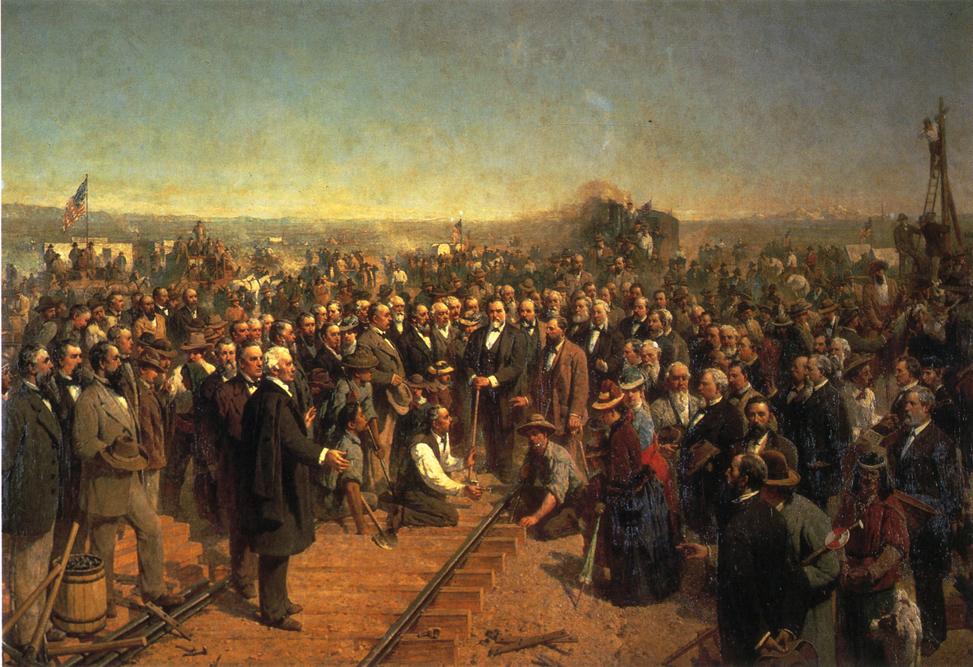
The first transcontinental railroad was 1,912 miles long, and was built to connect the east and the west coasts of the United States. It was commissioned by Congress in 1862. In the 1850s Congress saw that an effective rail network connecting the east to the west was needed to help with the rapid westward settlement. Before the Civil War, Congress needed to find the best route to the Pacific, so it commissioned a number of surveyors. Both Northern states and Southern states wanted the route to begin in their regions, which kept the Senate from being able to pass any legislation on the transcontinental railroad until the Southern states seceded from the Union in 1861. With the absence of Southern legislators from Congress, the northern route to the Pacific now met with little opposition. On July 1, 1862, the Pacific Railway Act became law and it offered incentives to men who were willing to help develop this first transcontinental railway. The two railway companies that were authorized to construct the rail network was the Union Pacific and the Central Pacific Railroad Companies. They were given government bonds and vast land grants.1
The Central Pacific was founded in 1861 by a group of California merchants known as the big four: Collis P. Huntington, Leland Stanford, Mark Hopkins, and Charles Crocker. They were best known for building the part of the transcontinental railroad that started in Sacramento, California, with Huntington representing the company in the East, handling the financing and purchasing aspects, and acting as a lobbyist. Crocker was in charge of the construction aspects, and Stanford, who was the governor of California in 1862–63, saw to the company’s financial and political interests in the West. To see to their need for labor, they employed thousands of Chinese laborers who made up between 80-90% of the Central Pacific work force, to work their way through the Sierra Nevada mountain range to meet the Union Pacific on the other side.2

With the Central Pacific building from the west, the Union Pacific was building from the east to meet up with them. The Union Pacific was incorporated by the Pacific Railway Act as well. It built 1,006 miles of track westward from Omaha Nebraska to meet the Central Pacific in Promontory, Utah, on May 10, 1869. Federal loans and land grants largely financed the company, like the Central Pacific, but the Union Pacific became embroiled in scandal when its financial branch, the Crédit Mobilier, was discovered to have individuals amassing enormous amounts of profits at the public expense. After discovery of this scandal of government funds, it almost destroyed the company. It still had a huge amount of debt in 1893, when it went under new ownership.3

Despite the scandal, the first transcontinental railroad was finally connected at Promontory, Utah on May 10, 1869 with an elaborate ceremony. Thomas Durant of the Union Pacific and governor Stanford of the Central Pacific took turns hammering the final “golden spike” into the ties that united the railways. As the celebration ended and the railroad was open for business, the impact was felt immediately as the travel time between the east and west was dramatically reduced from a few months to a simple week or less.4 The impact that this had on the United States was significant. It shortened the travel time and expanded interstate trade. It helped to spread ideas, and it also helped spread American culture, as the American people saw manifest destiny take on a very real form.
- Gale Encyclopedia of American Law, 2010, s.v. “Pacific Railroad Act,” edited by Donna Batten. ↵
- Development of the Industrial U. S. Reference Library, 2006, s.v. “Biographies,” Eds. Sonia G. Benson, Jennifer York Stock, and Carol Brennan. ↵
- Gale Encyclopedia of U.S. Economic History, 2000, s.v. “Union Pacific Railroad Company.” ↵
- Dictionary of American History, 2003, s.v. “Promontory Point,” by Oscar Osbur Winther. ↵
Tags from the story
Transcontinental Railroad